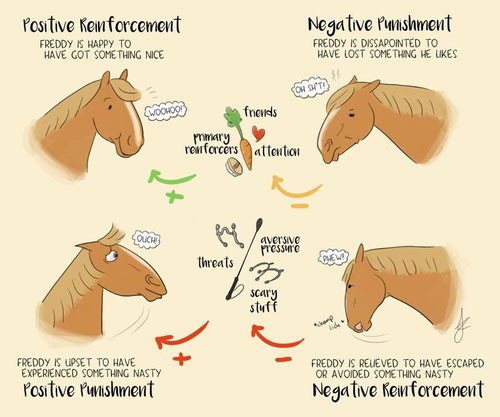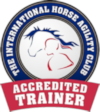Understanding Equine Training:
Introduction:
Equine training is an art form that requires a deep understanding of animal behavior, psychology, and effective training methods. One of the fundamental concepts in horse training is the use of operant conditioning, which involves manipulating consequences to modify behavior. Central to this approach are the concepts of quadrants, reinforcement, and punishment. In this blog post, we'll delve into these concepts and explore how they apply to equine training.
 (Picture Credit: "Fed up Fred")
(Picture Credit: "Fed up Fred")
Quadrants of Operant Conditioning:
Operant conditioning, as outlined by psychologist B.F. Skinner, involves four quadrants that describe the relationship between behavior and its consequences: positive reinforcement, negative reinforcement, positive punishment, and negative punishment.
- Positive Reinforcement: Positive reinforcement involves presenting a desirable stimulus immediately following a desired behavior, increasing the likelihood of that behavior occurring again. In equine training, this could involve giving a treat or praise to a horse after it performs a desired action, such as responding to a cue or completing a task.
- Negative Reinforcement: Negative reinforcement involves removing an aversive stimulus to increase the likelihood of a desired behavior. For example, if a horse responds correctly to a rider's leg aids, the pressure is released, reinforcing the desired response. Negative reinforcement should not be confused with punishment; it involves removing something unpleasant rather than adding something unpleasant.
- Positive Punishment: Positive punishment involves adding an aversive stimulus following an undesired behavior, decreasing the likelihood of that behavior occurring again. An example of positive punishment in equine training might be a sharp tug on the reins or a firm verbal reprimand following disobedience.
- Negative Punishment: Negative punishment involves removing a desirable stimulus following an undesired behavior, decreasing the likelihood of that behavior occurring again. For instance, if a horse kicks at another horse while being ridden, the rider might remove the horse from the group as a consequence, temporarily depriving it of the social interaction it desires.
Application in Equine Training:
Effective equine trainers understand how to use these quadrants judiciously to shape desired behaviors and discourage unwanted behaviors. Positive reinforcement is often the preferred method, as it creates a positive association between the desired behavior and a pleasant outcome, fostering trust and cooperation between horse and handler.
However, there are situations where negative reinforcement or punishment may be necessary, such as correcting dangerous behaviors or establishing boundaries. It's essential to use these methods sparingly and with sensitivity to the individual horse's temperament and learning style.
Conclusion:
Quadrants, reinforcement, and punishment are fundamental concepts in equine training, guiding trainers in shaping behavior and fostering a positive relationship between horse and handler. By understanding and applying these principles effectively, trainers can communicate with their horses in a clear, consistent, and respectful manner, leading to a rewarding partnership built on trust, mutual understanding, and cooperation.
.png)



